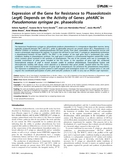Mostrar el registro sencillo del ítem
Expression of the gene for resistance to phaseolotoxin (argK) depends on the activity of genes phtABC in Pseudomonas syringae pv. Phaseolicola
| dc.creator | Aguilera, Selene | es_ES |
| dc.creator | Torre Zavala, Susana de la | es_ES |
| dc.creator | Hernández Flores, José Luis | es_ES |
| dc.creator | Murillo Martínez, Jesús | es_ES |
| dc.creator | Bravo, Jaime | es_ES |
| dc.creator | Álvarez Morales, Ariel | es_ES |
| dc.date.accessioned | 2014-05-14T07:34:50Z | |
| dc.date.available | 2014-05-14T07:34:50Z | |
| dc.date.issued | 2012 | |
| dc.identifier.issn | 1932-6203 | |
| dc.identifier.other | 510 | |
| dc.identifier.uri | https://hdl.handle.net/2454/10523 | |
| dc.description | Incluye material complementario | es_ES |
| dc.description.abstract | The bacterium Pseudomonas syringae pv. phaseolicola produces phaseolotoxin in a temperature dependent manner, being optimally produced between 18 degrees C and 20 degrees C, while no detectable amounts are present above 28 degrees C. Phaseolotoxin is an effective inhibitor of ornithine carbamoyltransferase (OCTase) activity from plant, mammalian and bacterial sources and causes a phenotypic requirement for arginine. To protect the cell from its own toxin, P. syringae pv. phaseolicola synthesizes a phaseolotoxin-resistant OCTase (ROCT). The ROCT is the product of the argK gene and is synthesized only under conditions leading to phaseolotoxin synthesis. The argK gene is included in a chromosomal fragment named Pht cluster, which contains genes involved in the synthesis of phaseolotoxin. The aim of the present work was to investigate the possible involvement of other genes included in the Pht cluster in the regulation of gene argK. We conducted transcriptional analyses of argK in several mutants unable to produce phaseolotoxin, transcriptional fusions and electrophoretic mobility shift assays, which allowed us to determine that genes phtABC, located within the Pht cluster, participate in the transcriptional repression of gene argK at temperatures not permissive for phaseolotoxin biosynthesis. This repression is mediated by a protein present in both toxigenic and nontoxigenic strains of P. syringae and in E. coli, and requires the coordinated participation of phtA, phtB and phtC products in order to carry out an efficient argK repression. | en |
| dc.description.sponsorship | This work was funded by grants from CONACYT (Consejo Nacional de Ciencia y Tecnología; http://www.conacyt.mx), research grant SEP-2006-C01-49958/24089 to AAM and SA (Postdoctoral scholarship), and from the Spanish Plan Nacional I+D+I grant AGL2008-55311-CO2-01 (Ministerio de Ciencia e Innovación; http://micinn.es/), co financed by FEDER, to JM. | en |
| dc.format.mimetype | application/pdf | en |
| dc.format.mimetype | application/zip | en |
| dc.language.iso | eng | en |
| dc.publisher | Public Library of Science | en |
| dc.relation.ispartof | Plos One, 2012, 7 (10): e46815 | en |
| dc.rights | © 2012 Aguilera et al. This is an open-access article distributed under the terms of the Creative Commons Attribution License, which permits unrestricted use, distribution, and reproduction in any medium, provided the original author and source are credited. | en |
| dc.rights.uri | http://creativecommons.org/licenses/by/3.0/ | |
| dc.subject | Two ornithine carbamoyltransferases [2 ornithine carbamoyltransferases] | en |
| dc.subject | Halo blight | en |
| dc.subject | Phytotoxin coronatine | en |
| dc.subject | Beta glucuronidase | en |
| dc.subject | Toxin | en |
| dc.subject | Production | en |
| dc.subject | Biosynthesis | en |
| dc.subject | Cluster | en |
| dc.subject | Protein | en |
| dc.subject | Temperature | en |
| dc.subject | Regulator | en |
| dc.title | Expression of the gene for resistance to phaseolotoxin (argK) depends on the activity of genes phtABC in Pseudomonas syringae pv. Phaseolicola | en |
| dc.type | Artículo / Artikulua | es |
| dc.type | info:eu-repo/semantics/article | en |
| dc.contributor.department | Producción Agraria | es_ES |
| dc.contributor.department | Nekazaritza Ekoizpena | eu |
| dc.rights.accessRights | Acceso abierto / Sarbide irekia | es |
| dc.rights.accessRights | info:eu-repo/semantics/openAccess | en |
| dc.identifier.doi | 10.1371/journal.pone.0046815 | |
| dc.relation.projectID | info:eu-repo/grantAgreement/ES/6PN/AGL2008-55311 | en |
| dc.relation.publisherversion | https://dx.doi.org/10.1371/journal.pone.0046815 | |
| dc.type.version | Versión publicada / Argitaratu den bertsioa | es |
| dc.type.version | info:eu-repo/semantics/publishedVersion | en |



